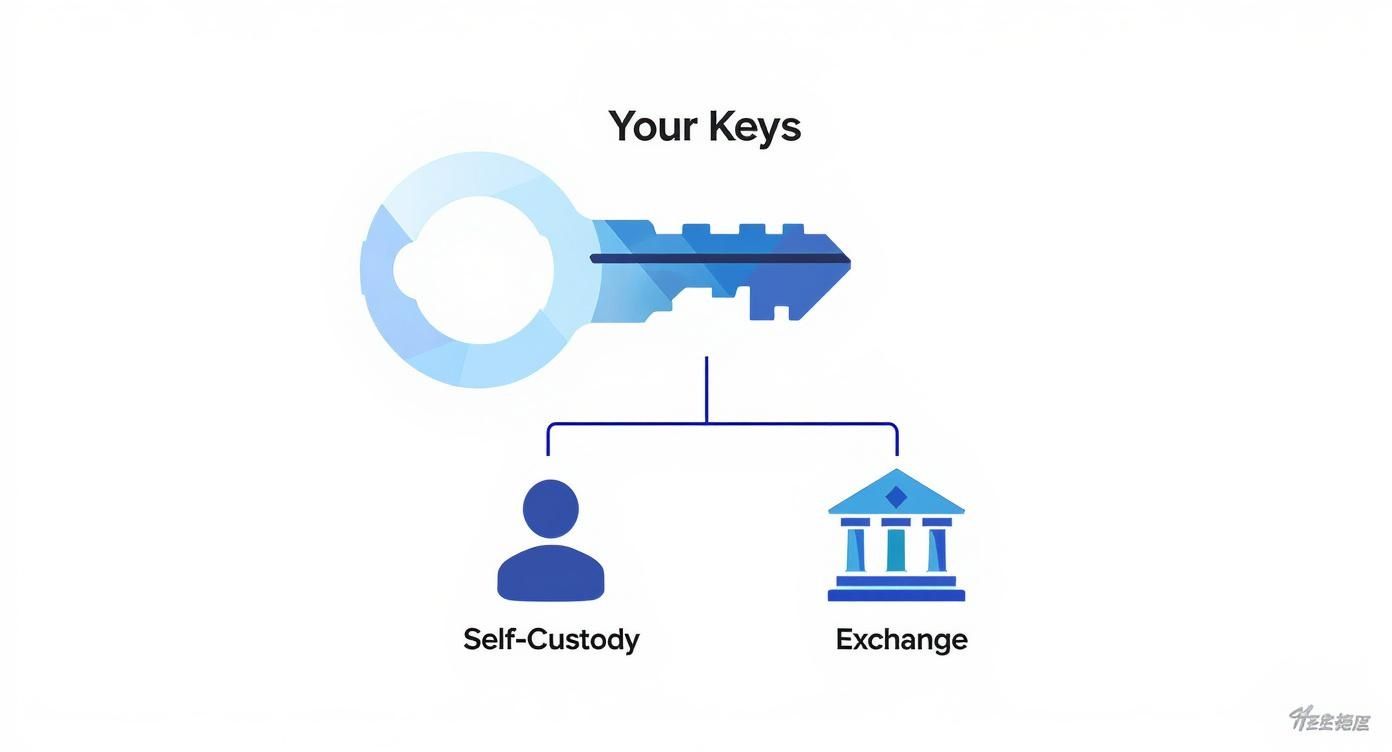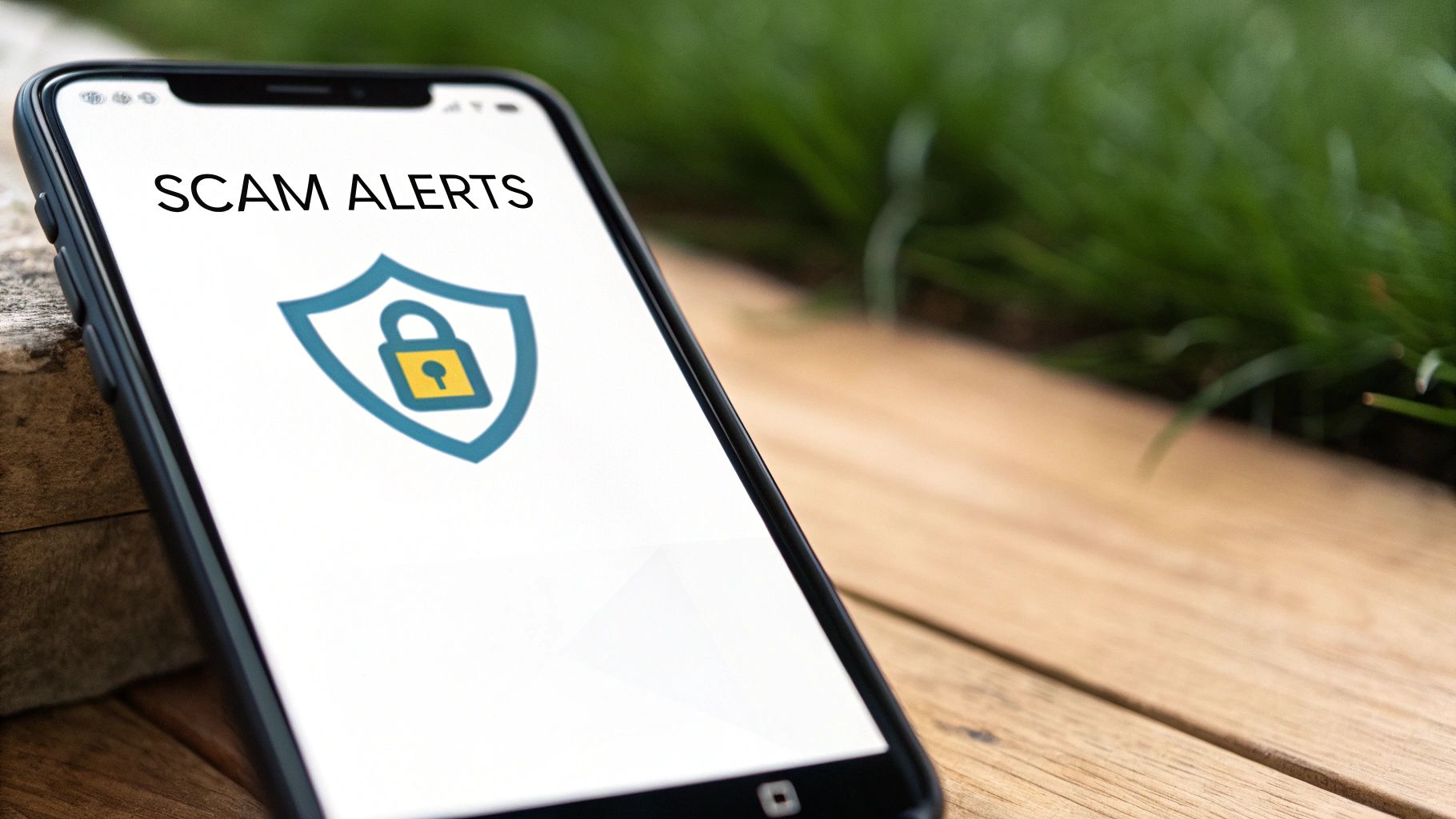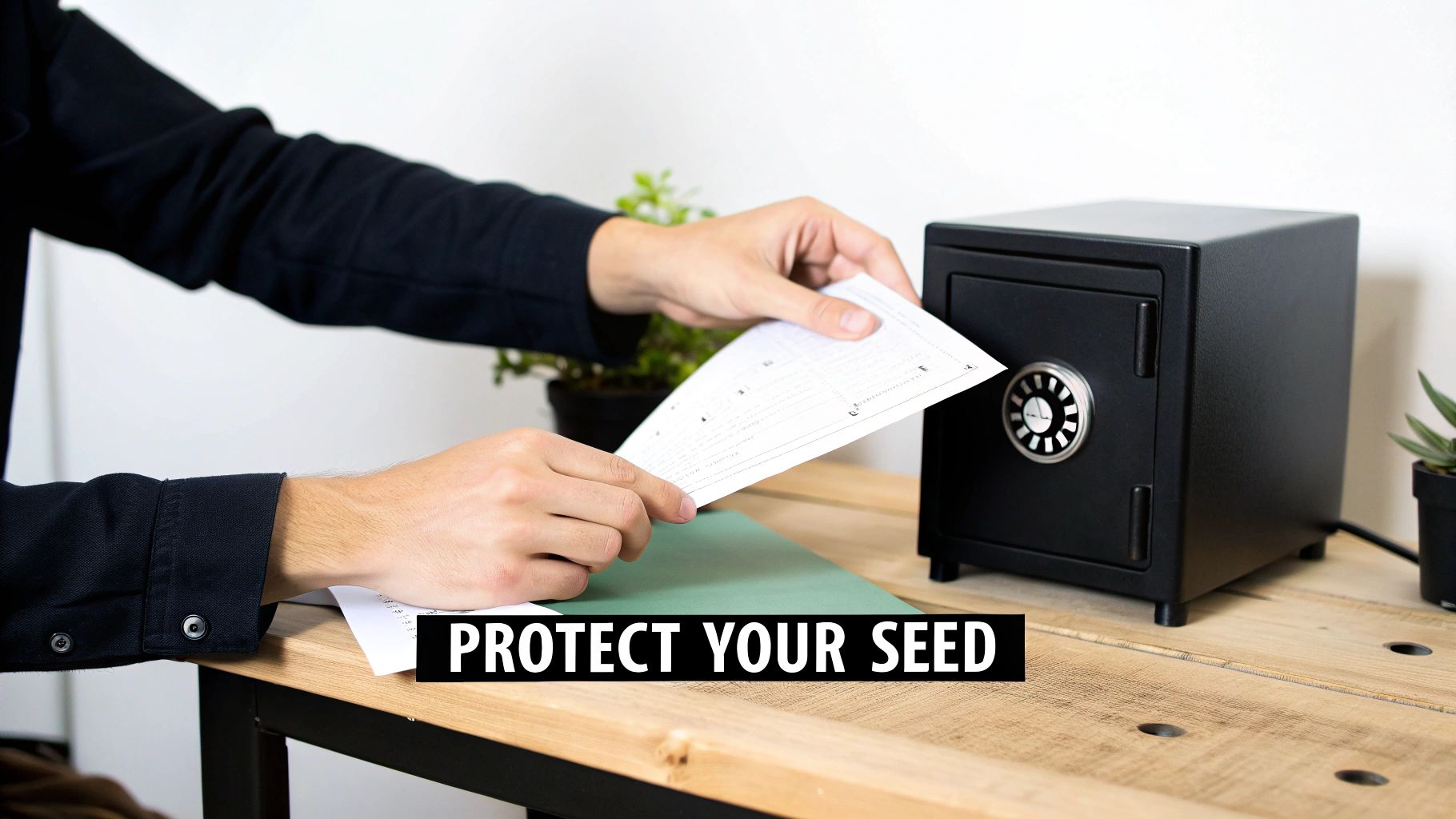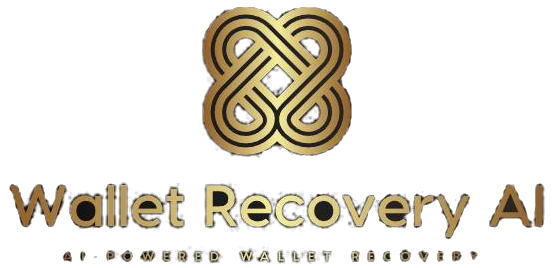The security of your Coinbase Wallet boils down to one simple, powerful idea: you control your keys. This isn't just a small detail—it's what makes the Wallet a completely different beast from holding your crypto on the regular Coinbase exchange.
Think of it like this: your Coinbase Wallet is your own personal digital fortress, and you're the only one with the keys to the gate. The Coinbase exchange, on the other hand, is more like a bank's vault. They guard it for you, but ultimately, they hold the master key.
Your Crypto, Your Keys: Getting to Grips with Self-Custody
To really understand what makes the Coinbase Wallet tick, we need to talk about self-custody. Unlike your bank account or even your standard Coinbase.com account, a self-custody wallet gives you absolute, direct control over your digital assets. There's no middleman, no company administrator, and no third party who can freeze or access your funds. It's just you.
The Coinbase exchange is what we call a custodial service. When you buy Bitcoin on the exchange, Coinbase is the custodian—they hold the private keys on your behalf, much like a bank holds your cash. The Wallet, however, is non-custodial. It generates a unique set of private keys that are stored only on your device, completely under your command.
This is the most important takeaway: With self-custody, you are your own bank. This brings incredible freedom and true ownership over your crypto, but it also means the responsibility for keeping those keys safe lands squarely on your shoulders.
What's All This Talk About Private Keys and Seed Phrases?
So, what exactly are these "keys" we keep mentioning? They're the core of your wallet's security.
- Private Keys: Think of a private key as the master password for your crypto. It's a long, complex string of cryptographic code that proves you own your assets and gives you the power to sign transactions and spend them.
- Seed Phrase (or Recovery Phrase): This is a list of 12 words that acts as the ultimate backup for your entire wallet. If your phone gets lost, stolen, or broken, this phrase is the only way to restore your wallet and access your funds on a new device.
Coinbase Wallet is designed from the ground up as a self-custody mobile and browser wallet, putting you in the driver's seat. The app never stores your private keys on its own servers. Instead, they live securely on your device, protected by an additional layer of powerful AES-256 encryption if you choose to back them up to a cloud service like iCloud or Google Drive.
For a deeper dive into how this all works, our guide on custodial vs non-custodial wallets breaks it down even further.
Coinbase Wallet vs Exchange Security At a Glance
It’s easy to get the two confused, but their security models couldn't be more different. Here’s a quick table to show you exactly where those differences lie.
| Security Feature | Coinbase Wallet (Self-Custody) | Coinbase Exchange (Custodial) |
|---|---|---|
| Private Key Control | You hold and control your keys. | Coinbase holds the keys for you. |
| Asset Access | Only you can access your crypto. | Coinbase can access and manage funds. |
| Primary Responsibility | You are responsible for securing your seed phrase. | Coinbase is responsible for platform security. |
| Recovery Method | Restore with your 12-word seed phrase. | Reset password through Coinbase support. |
| Vulnerability Point | Losing your seed phrase or device compromise. | Centralized exchange hacks or account takeover. |
Ultimately, the choice between the Wallet and the Exchange comes down to a trade-off: do you prefer the total control (and total responsibility) of the Wallet, or the convenience (and third-party trust) of the Exchange?
The Technology That Shields Your Funds
Okay, so you get that you control the keys. But how, exactly, does the wallet keep them safe? Coinbase Wallet’s security isn’t just one single feature; it’s a stack of different technologies layered on top of each other, creating a digital fortress right on your device.
It all starts the second you set up your wallet. Your private keys are generated and immediately locked down in the local storage of your phone or computer. The critical part? They never touch Coinbase's servers. This is the entire foundation of self-custody. It’s why a massive hack on an exchange's central servers won't affect the funds in your personal wallet.
This diagram nails the difference between self-custody (where you hold the keys) and custodial services (where they hold them for you).

As you can see, with self-custody, there’s no one standing between you and your assets. It’s direct control, period.
Hardware-Level Isolation
For a lot of us, especially on modern iPhones, the security goes way deeper than just the app itself. Coinbase Wallet hooks into hardware-level protection like the Secure Enclave.
Think of the Secure Enclave as a separate, maximum-security vault that's physically built into your phone's main chip.
This little fortress is specifically designed to handle the most sensitive data—your private keys, your Face ID scans, that sort of thing. It's completely isolated from the main operating system where you run Instagram and check your email. This creates an almost impenetrable wall. Even if some nasty malware managed to infect your phone, it would have an incredibly tough time trying to crack into the secrets locked away in that hardware vault.
Encryption and Biometric Safeguards
So, what about someone physically getting your phone or trying to access your cloud backup? Coinbase Wallet has that covered, too. It ties directly into your device's built-in biometrics, like Face ID or a fingerprint scan. This adds a crucial physical gatekeeper, making sure only you can open the app and authorize transactions.
This biometric check is like a bouncer for your digital vault. No ID, no entry. It demands proof that you're you before swinging open the door to your crypto.
And if you decide to back up your seed phrase to a cloud service like iCloud or Google Drive, it’s not just sitting there unprotected. It gets locked down with AES-256 encryption, which is the same gold standard used by banks and governments. This means that even if a hacker broke into your Google Drive, all they'd see is a jumbled mess of unreadable text. Without your password, that recovery phrase is useless to them. It's serious peace of mind for your backup.
Why Your Wallet Isn't the Same as the Coinbase Exchange
It's easy to get a knot in your stomach when you see a big crypto company in the news for a security issue. But when it comes to the safety of your Coinbase Wallet, it’s crucial to understand one thing: a problem at the main exchange is a world away from your personal, self-custody wallet. They operate in completely different universes.
Think of the main Coinbase exchange as a massive, central bank vault. A breach there might involve someone trying to crack the vault door or trick a guard. Your Coinbase Wallet, on the other hand, is like a personal safe buried in your backyard. Only you have the map and the key. A robbery at the main bank doesn’t magically give thieves access to your hidden stash.
This isn't an accident; it's by design. Your private keys—the only way to access your funds—are stored directly on your phone or computer. They are physically and digitally separate from the massive servers and company-wide systems that run the exchange.
A Real-World Test of This Separation
Let's look at a real-life example that puts this theory to the test. In a past security incident, attackers targeted Coinbase's customer support systems. They managed to get their hands on some internal customer data—a serious issue, for sure.
But here’s the critical part: not a single penny was touched in users' Coinbase Wallets. The attackers did not get any login details, 2FA codes, or private keys. The wall between the company’s operational systems and users' self-custody keys held up perfectly. Even with a breach on the corporate side, the funds in individual wallets remained completely secure. You can read a full breakdown of the incident to see exactly how this separation protected users.
This incident is the perfect case study. It proves that even when a company’s outer defenses are compromised, the core principle of a self-custody wallet—where you and only you hold the keys—works exactly as it should.
The Bottom Line: Where Does the Real Risk Lie?
Understanding this difference is everything. The threats you face are fundamentally different depending on where you keep your crypto.
- Exchange Risk: This is all about centralized points of failure. Think massive server hacks, insiders gone rogue, or phishing attacks targeting the platform itself.
- Wallet Risk: This is almost entirely about you. The danger comes from losing your seed phrase, getting a virus on your own device, or being tricked into giving away your keys.
So, while it’s always smart to keep an eye on security headlines, don't confuse a report about an exchange with the safety of your personal wallet. Its design ensures that as long as you protect your device and your seed phrase, your crypto is sealed off from those big, platform-wide threats. In the world of self-custody, you are the final and most important line of defense.
Proactive Features Guarding You From Web3 Scams

A strong foundation is great, but how does Coinbase Wallet hold up when you’re out exploring the wilds of Web3? Beyond just locking down your keys, the wallet is designed to be a smart co-pilot on your journey. Think of it as having digital guardrails to keep you safe from the ever-growing army of scammers and bad actors.
These aren't just passive defenses sitting in the background. They are active, real-time alerts designed to help you make smarter, safer decisions on the fly.
One of the most valuable is the dApp browser warning system. Let's say you click a shady link and try to connect to a website or app that's known for phishing or other scams. The wallet will throw up an impossible-to-miss warning. This blocklist is constantly being updated, acting like an early-warning system that can stop a disaster before you even connect.
Your Final Checkpoint: Transaction Previews
Think of transaction previews as your last line of defense before your funds are on the line. Whenever you're about to interact with a smart contract—maybe for a token swap, an NFT mint, or a DeFi deposit—Coinbase Wallet gives you a clean, human-readable summary of exactly what you’re signing off on. This is your chance to hit the pause button and double-check everything.
Instead of a confusing wall of code, the preview breaks it down for you:
- What you are giving: It clearly spells out the exact amount and type of token that's about to leave your wallet.
- What you are receiving: It shows you the asset you should be getting in return.
- The permissions you grant: Crucially, it outlines what kind of access the smart contract is asking for.
This clarity is a direct countermeasure to a common scam where a malicious contract tricks you into giving it unlimited access to your tokens, only to drain your wallet clean later on.
It's a bit like your bank calling to confirm a large, unusual wire transfer. These previews force you to take a deliberate second look, empowering you to spot red flags and back out before you sign a transaction that could cost you everything.
Avoiding The Threat of Malicious Token Approvals
A particularly sneaky kind of attack involves tricking you into "approving" a smart contract to spend your tokens on your behalf. To combat this, Coinbase Wallet has built-in explicit token approval alerts. If a dApp asks for really broad permissions—like the ability to spend all of your USDC whenever it wants—the wallet flags it as a high-risk move.
This feature helps you instantly see the difference between a simple, one-time swap and giving a protocol the keys to your kingdom. By shining a spotlight on these critical permissions, the wallet helps you avoid accidentally signing away control of your crypto. These built-in safety nets are a huge part of what makes the wallet a secure gateway to Web3, not just a vault for your coins.
You're the Head of Security

Coinbase Wallet packs a serious technological punch, creating a digital fortress to guard your assets. But here’s the unvarnished truth about self-custody: you are the ultimate gatekeeper. All the world-class encryption and hardware protection can be bypassed if you accidentally leave the keys lying around.
Think of it like owning a high-tech safe. The manufacturer built it with a complex lock and reinforced steel, but if you scribble the combination on a sticky note and leave it on your desk, the safe's strength is totally irrelevant. Your personal security habits are what make or break your wallet's defense.
The good news is that mastering just a few core practices will transform you from a passive user into an active, confident defender of your crypto.
Guarding Your Master Key
Your 12-word seed phrase is the whole game. It's not just a password—it's the master key that can regenerate your entire wallet on any device, anywhere in the world. Protecting it is your single most important job.
This phrase is your ultimate lifeline. Phone gets stolen? You use the phrase to get your funds back. But if someone else gets their hands on it, they can drain your wallet in minutes. The power of this phrase is immense, which is why it's so critical to understand how to handle it. You can learn all about your wallet recovery phrase and why it's so vital.
Treat your seed phrase like it's a bar of physical gold. It should never, ever touch the digital world. That means no screenshots, no saving it in a notes app, and definitely no emailing it to yourself. Write it down on paper and store it somewhere safe, private, and maybe even fireproof.
Building Layers of Defense
Beyond the all-important seed phrase, your everyday habits create crucial layers of protection. This starts with locking down the devices and accounts that connect to your wallet.
- Secure Your Cloud Backup: If you back up your encrypted wallet file to iCloud or Google Drive, that account needs to be a fortress. Use a strong, unique password and enable two-factor authentication (2FA). This puts another locked door between an attacker and your backup.
- Practice Good Device Hygiene: Always keep your phone’s operating system and the Coinbase Wallet app updated. Those little update notifications often contain vital security patches that plug newly discovered holes.
- Stay Vigilant and Skeptical: Never share your seed phrase with anyone. This is especially true for people online claiming to be support staff. Coinbase will never ask you for your seed phrase. Ever.
Your Personal Security Checklist for Coinbase Wallet
Keeping track of these security measures can feel like a lot, but they quickly become second nature. This simple checklist breaks down the most critical actions you need to take to secure your Coinbase Wallet.
| Action Item | Why It's Critical | How-To Tip |
|---|---|---|
| Write Down Your Seed Phrase Offline | This is the master key to your funds. If it's stored digitally, it can be hacked. | Use pen and paper. Store it in multiple, secure, physical locations that only you know about. |
| Enable 2FA on Your Cloud Account | Protects the encrypted backup of your wallet from being accessed if your cloud password is stolen. | Go to your Google or iCloud security settings and activate two-factor authentication, preferably with an app. |
| Set a Strong, Unique PIN/Password | This is your first line of defense against someone who gets physical access to your device. | Use a complex, non-obvious PIN. For biometric-enabled devices, use your fingerprint or Face ID. |
| Keep Your App and OS Updated | Updates patch security vulnerabilities that hackers could otherwise exploit. | Turn on automatic updates for both your phone's operating system and the Coinbase Wallet app. |
| Never Share Your Seed Phrase | Anyone with your seed phrase can steal all of your assets. There are no do-overs. | Be suspicious of all unsolicited DMs or emails. Remember: Coinbase will never ask for it. |
Following this checklist doesn't just add a little security—it fundamentally strengthens your entire setup.
Putting these simple, actionable steps into practice is how you fortify your defenses. It ensures the powerful security tech built into the wallet can actually do its job. The real secret to bulletproof crypto security is combining robust technology with a vigilant, well-informed user. And that user is you.
So, How Does Coinbase Wallet Stack Up?
To really get a feel for Coinbase Wallet's security, you have to place it in the broader world of crypto storage. Not all wallets are built the same—they're different tools for different jobs. The biggest split is between "hot wallets," like Coinbase Wallet, and "cold storage" hardware wallets.
Coinbase Wallet is a hot wallet. That just means it’s a software app running on a device connected to the internet, like your phone or laptop. This connection is its best feature and its biggest trade-off. It gives you instant access to your crypto, which is perfect for everyday stuff like trading on DEXs, messing with dApps, or shooting some ETH to a friend.
But being online all the time naturally opens the door to online risks. It helps to think of a hot wallet like the cash you keep in your actual, physical wallet. It's super convenient for daily spending, but you wouldn't walk around with your life savings stuffed in your back pocket.
The Fort Knox of Crypto: Cold Storage
At the other end of the security spectrum, you have cold storage hardware wallets—think devices from companies like Ledger or Trezor. These are physical gadgets that keep your private keys completely offline, in what’s called an "air-gapped" environment. When you need to sign a transaction, it happens right on the device itself, so your keys never, ever touch the internet.
This design makes them practically immune to online attacks like malware or phishing scams.
- Maximum Security: These are built for the long haul. They’re perfect for stashing away the crypto you don’t plan on touching anytime soon.
- Slower Access: Using one means physically plugging it in and going through a few extra steps. It’s not built for split-second trades.
- Offline by Design: This is their superpower. They shield you from remote hacks, which are the number one threat to hot wallets.
A cold wallet is like a bank vault. It’s the most secure place for your serious assets, but you don't pop over to the vault every time you want to buy a coffee.
Finding Your Balance
Look, the conversation isn't really about "hot vs. cold." It’s about building a smart, layered security strategy. For anyone serious about crypto, the answer isn’t to pick one or the other—it's to use both for what they do best.
A really common and effective setup is to use Coinbase Wallet for your "spending" money—the crypto you're actively using for trading, DeFi, and exploring Web3. At the same time, the bulk of your portfolio, the assets you're holding for the long term (your "HODL" bag), sits safely in an offline hardware wallet.
This hybrid approach gives you the best of both worlds: the grab-and-go convenience of a hot wallet for daily use and the fortress-like security of cold storage for your core holdings. It’s all about creating a balanced, resilient setup that works for you.
Common Questions About Wallet Security
When you're dealing with self-custody, a few questions are bound to pop up. Let's clear the air on some of the most common concerns people have when securing their crypto with Coinbase Wallet.
Is Coinbase Wallet More Secure Than a Bank Account?
Think of it this way: Coinbase Wallet is like having your own personal, digital Fort Knox. A bank is more like a shared vault.
With Coinbase Wallet, you hold the one and only key—your seed phrase. You have absolute, direct control. A bank, on the other hand, operates on a custodial model. They hold the keys, and while your money is often insured by the government, it's still subject to institutional risks.
The security of your Coinbase Wallet is rock-solid, but it all comes down to how well you guard that seed phrase.
What if I Lose My Phone?
Losing your phone is a pain, but it doesn't have to mean losing your crypto. As long as you have that 12-word recovery phrase safely stored somewhere, you can get everything back on a new device.
Just download the Coinbase Wallet app, select "I already have a wallet," and follow the prompts to restore it. This is precisely why we say protecting your seed phrase is the most important thing you can do.
Can Coinbase Touch My Funds or Freeze My Wallet?
Nope. Not a chance. Since Coinbase Wallet is a self-custody product, Coinbase has zero access to your private keys. They can't move your funds, and they can't freeze your account.
This is the biggest difference between the Wallet and a regular account on the Coinbase exchange. You, and only you, are in complete control.
The entire concept of self-custody is what makes Coinbase Wallet so secure. It builds a wall between your assets and any central company, including Coinbase. This means even if there's a major issue at the company level, your funds are firewalled off from it.
This model hands you true ownership, which also means your personal security habits become the final, most critical defense for your crypto.
If you've lost access and need professional help, the team at Wallet Recovery AI specializes in advanced techniques to help users securely get back into their digital wallets. Find out more about our secure recovery services.


Leave a Reply